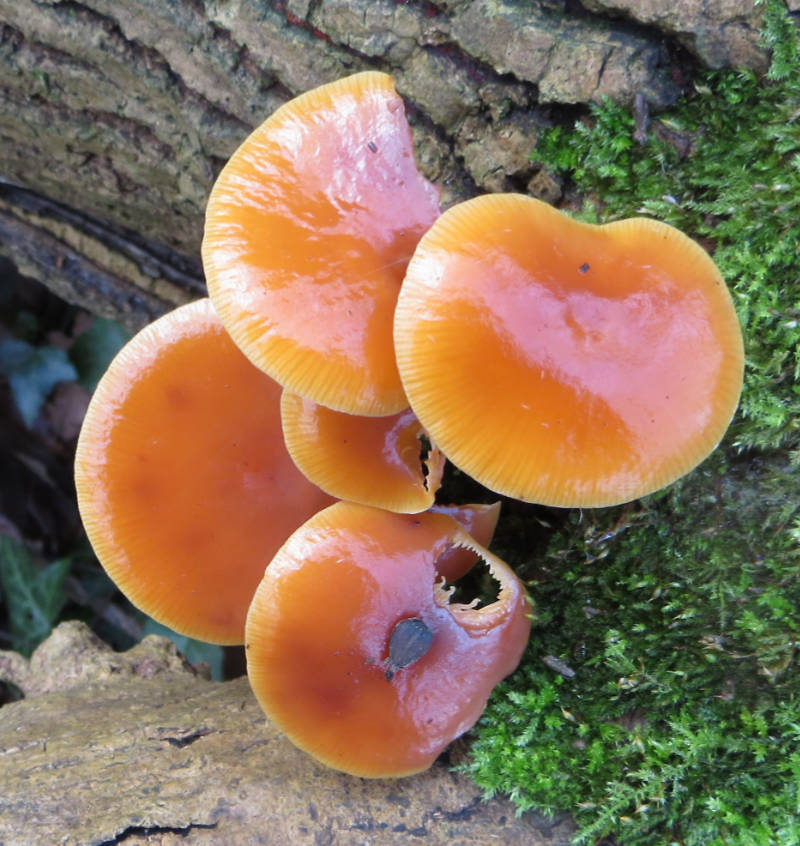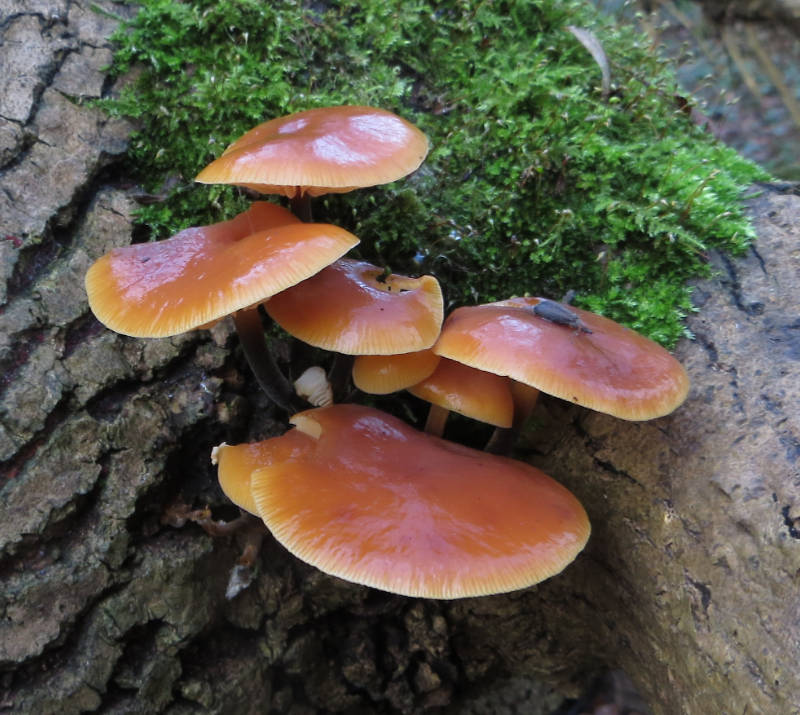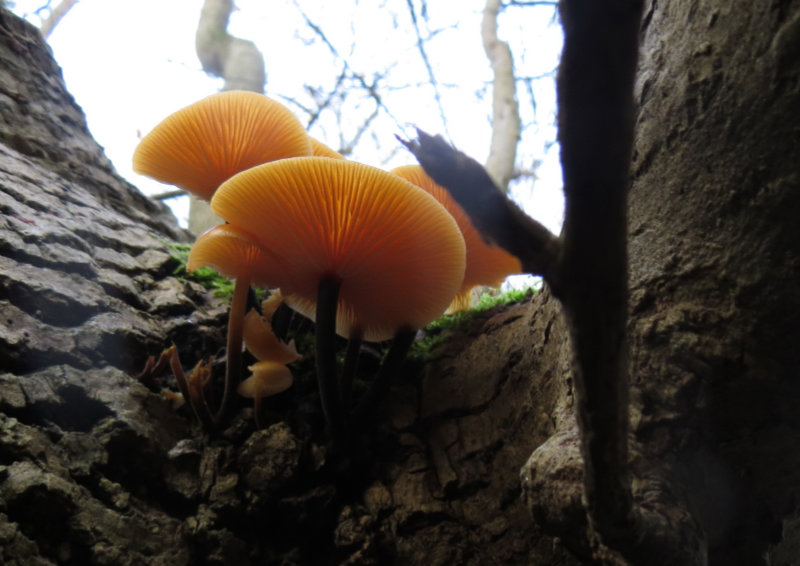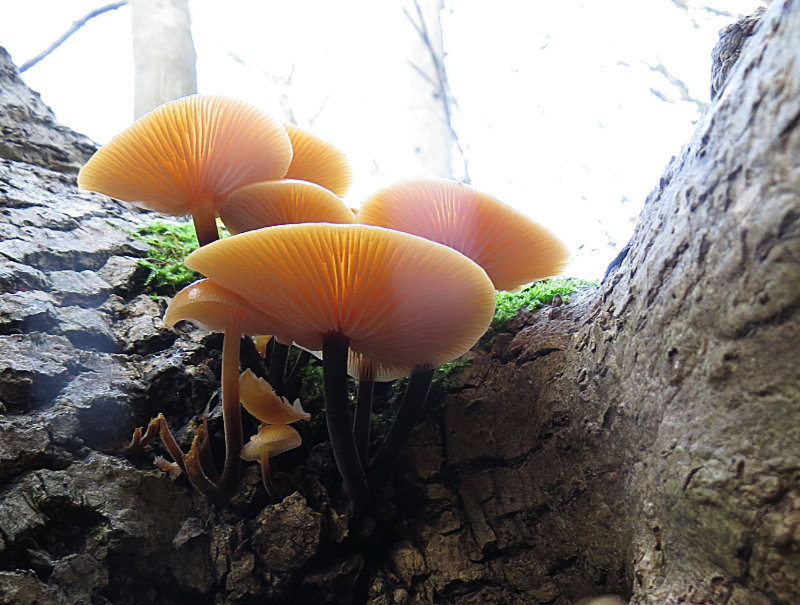On a recent visit to the woods, I found this clump of fungi which I believe are Common Stump Brittlestem. When photographing fungi I like to include the underside in at least one shot so that I can record the gills. The problem here was how to get down to this level. The clump were growing in the fork of a fallen tree. The first picture shows them from above.
#1 From above
It was not possible to get myself between the arms of the fork, so I held my camera as best I could for a profile:
#2 Profile
OK so far, but this profile did not show the underside of the gills. With a bit of contortion of my body, sticking my head between the fork, I was able to take two more pictures which showed the underside. In each case I dialled in a bit of exposure compensation.
#3 Undreside
#4 Underside
My problem is, as you can see the background is very overexposed. My question is how could I avoid this next time. I have tried fixing it in PP without much success. The photos were taken with a Canon PowerShot. I would not have been able to get my DSLR in the space between the branches so it was that or nothing! I do have some LED light bars which I am thinking of trying next time.
Most of my pictures of fungi are taken at ground level, so these LED light bars work well, but I suspect that in the current circumstance I would have difficulty.
Suggestions welcome.
John
Results 1 to 20 of 33
Thread: Photographing Fungi
-
31st December 2016, 12:14 PM #1
Photographing Fungi
Last edited by JohnRostron; 2nd January 2017 at 09:25 AM.
-
31st December 2016, 01:01 PM #2
Re: Photographing Fungi
Easy fixes would be to shoot at an angle, side lighting might work better anyway or shoot at different time of day. You could try exposure compensation or set camera exposure for the lights.
-
31st December 2016, 01:53 PM #3

- Join Date
- Jul 2015
- Location
- Thornhill, a suburb of Toronto, Ontario Canada
- Posts
- 970
- Real Name
- Robert
Re: Photographing Fungi
A very handy photo accessory is an umbrella for taming light.
I keep a white nylon golf umbrella in my trunk for such situations. It allows sunlight to pass through, while diffusing it.
Mine came from a company that produces incentive products and bling gifts (branded pens, calendars etc. that companies use as giveaways). I simply asked to purchase a golf umbrella with no markings. It even has a plastic spike in the base to anchor it in the ground.
Another handy accessory for situations as you described is a piece of cloth with an soft, amorphous pattern of greens printed on it to place behind subject matter like your Fungi to eliminate the bald sky. Try a fabric store, or army surplus store for a piece of camouflage fabric.
I hope these ideas help.
Robert
-
31st December 2016, 02:09 PM #4
-
31st December 2016, 02:16 PM #5
Re: Photographing Fungi
Thanks, Shadowman. Shooting at an angle would not work, given the configuration of the branches. I'm not sure a different time of day would work, but shooting in overcast weather might. The day I took these was a clear blue sky. As you can see in #4, the brightness produces a halo around the caps.
John
-
31st December 2016, 02:31 PM #6
Re: Photographing Fungi
John, I would say its Velvet Shank, Flammulina velutipes. As to shooting up into the light well depends on what you want a record shot and it does not matter - a 'art' image it matters and the camo cloth at a suitable distance to be out of Focus is probably the best bet. Expose for the gills and balance the background later
Brittlestem - http://www.first-nature.com/fungi/ps...luliformis.php
I also find carrying a piece of scrunged up and hten flattened metal foil and using that as a reflector under the fungi but out of shot reflects a lot of light under the cap to give me the detail and helps balance the contrast a lot.
-
31st December 2016, 02:32 PM #7

- Join Date
- Jun 2013
- Location
- North West of England
- Posts
- 7,178
- Real Name
- John
Re: Photographing Fungi
Nice set John. I only ever seem to find half eaten specimens. The alternative for the last two would be to expose for the sky and balance with a bit of diffused fill in flash.
-
31st December 2016, 02:33 PM #8

- Join Date
- Feb 2012
- Location
- Texas
- Posts
- 6,956
- Real Name
- Ted
Re: Photographing Fungi
It's a great pity that the gill pattern is revealed so well by the same light that's giving all that flare and the blown sky. And lighting from underneath with some form of fill light (LED, flash) might well reduce the contrast of the said gills - as indeed would a significant reduction of the light from above by diffusion or blocking.
Perhaps a combination of blocking the light over the clump in combination with a white or silver reflector underneath, assuming there's room?
John, what would be your ideal lighting for shooting those gills?
Psst . . wanna borrow my chainsaw?
-
31st December 2016, 02:37 PM #9
Re: Photographing Fungi
If you are wanting to see more fungi and get help with IDs etc - a Facebook site I access is this one - https://www.facebook.com/groups/18843741618/
The British Mycological Society (BMS)
-
31st December 2016, 03:17 PM #10
Re: Photographing Fungi
Shoot with a polarizer. I see all kinds of signs of glare on your images. You will get this even on cloudy and rainy days or in shaded areas of the woods. It is the only way to get rid of that issue.
This means losing a couple of stops of light, so you should consider carrying a small tripod too.
-
31st December 2016, 03:21 PM #11
Re: Photographing Fungi
In this situation, I wonder if a grad filter would have helped to balance the disparity in lighting. A reflector or fill flash would help as well.
-
31st December 2016, 03:22 PM #12
Re: Photographing Fungi
John,
I have done only a little work with fungi, so consider these the ideas of a rank amateur.
First, you have two different issues, the blown sky and flare. I don't think you can avoid this given the position of the camera. Perhaps you could if you aimed the camera further down and tilted it slightly, and you might have to shade the lens with your hand or something else other than the hood.
I have started experimenting with an off-camera flash. I use the same diffuser as I do with bugs, but I use a cable to allow me to hold the flash wherever I want. That might work, although you might need to use a tripod to hold the camera if you can't hold it steady enough with one hand.
Dan
-
31st December 2016, 03:49 PM #13
Re: Photographing Fungi
If your Powershot shoots RAW*, were you using that John?
* I suspect most do, even my pocketable Canon S100 (sub Powershot size) does.
If you shot RAW, this may give you more highlight recovery options than a jpg will, especially using ACR or LR.
Some good ideas above already, shading the lens to prevent flare solves one, adding some light from below, by reflector or on-camera fill flash might be another.
Getting a companion to block the sky, especially if in Camo is another, although you do then lose the context of the shooting angle without the sky being 'up there'.
A cloudy white sky might well have been worse than the blue sky - I know I'd rather shoot birds from below against a blue sky than cloudy overcast, as I can get a 2 stop higher exposure on subject for a given amount bg overload.
HTH, Dave
-
31st December 2016, 07:27 PM #14
-
31st December 2016, 07:31 PM #15
-
31st December 2016, 07:35 PM #16
-
31st December 2016, 07:36 PM #17

- Join Date
- Jan 2009
- Location
- South Devon, UK
- Posts
- 14,417
Re: Photographing Fungi
There are two reasons to photograph fungi, John. To create a pleasing scene; something which could be hung on your wall, etc. Or for identification purposes. In many cases you can achieve both.
Avoiding sunshine, or even rather bright indirect light in some cases, has already been mentioned. I always use some form of light restriction for fungi, particularly the shiny and greasy types. You may get away with natural cover on overcast days but some form of diffuser is frequently required. I have a Lastolite Difflector for that purpose but I don't always carry it so I will also use my Lastolite fold up white balance card or simply use my body shadow to create a little bit of shadow.
This usually requires a fairly long exposure, partly due to requiring a narrow aperture for increased focus depth, so a tripod is essential. Taking multiple shots for focus stacking can produce the best focus depth, otherwise some care will be required to decide which parts can be left to fade into softness.
Before shooting, have a good look at the scene and clean up any debris on the fungi; unless that is specifically required. Also do a bit of gardening around the subject to prevent any obstructions or excessively reflective areas such as wet leaves, etc. Some imperfect fungi may need to be removed.
Take some time over choosing the best angles.
If shooting for identification it is handy to pick one of the fungi and lay it down at an angle which clearly shows the stem and gills; with particular reference to how the gills are attached to the stem. I frequently add a ruler to these shots so as to help with identification when I return home.
But if you are serious about identification the best option, which is used by the fungi experts, is to carefully take one home to produce a spore print. The colour of the spores is a great help with identification because so many fungi are virtually identical or can be quite variable. Spores can vary from white through various shades of yellow or brown to black.
In some cases the spores need to be examined under a microscope to see their shape for a full identification. However, many fungi amateurs are content merely to arrive at the family level.
For example, I agree with Flammulina as a possible identification for these images but there are alternatives. Is the stem dark brown, particularly towards the base with a velvet like texture and are the gills adnexed where they meet the stem. There are a number of strange sounding words to describe the shape of the gills and this can be tricky to learn.
Fungi photography can be an interesting hobby but it tends to be something of a minefield when first starting.
-
31st December 2016, 07:39 PM #18
Re: Photographing Fungi
Thanks to all for your suggestions. I will visit the woods again tomorrow armed with a couple of LED bars, some camouflage bg and my Canon Hacker's card. I might even try to squeeze my Sony DSLR down the crack! Let's hope the fungi are still there.
JOHN
-
31st December 2016, 07:40 PM #19

- Join Date
- Jan 2009
- Location
- South Devon, UK
- Posts
- 14,417
Re: Photographing Fungi
ps. This interactive auto identification fungi key can be a great help in narrowing down your options,
http://www.mycokey.com/newMycoKeySit...dentQuick.html
-
31st December 2016, 07:46 PM #20
Re: Photographing Fungi
Thanks Geoff. I am not a fungus expert, but I am an experienced field biologist, so I am familiar with the technical terminology and I have been on several forays with the experts. I no longer have access to a microscope though since I retired. I am trying to expand my fungus identification skills, preferably without removing them from their habitat, but I will if needs be.
John

 Helpful Posts:
Helpful Posts: 




 Reply With Quote
Reply With Quote

